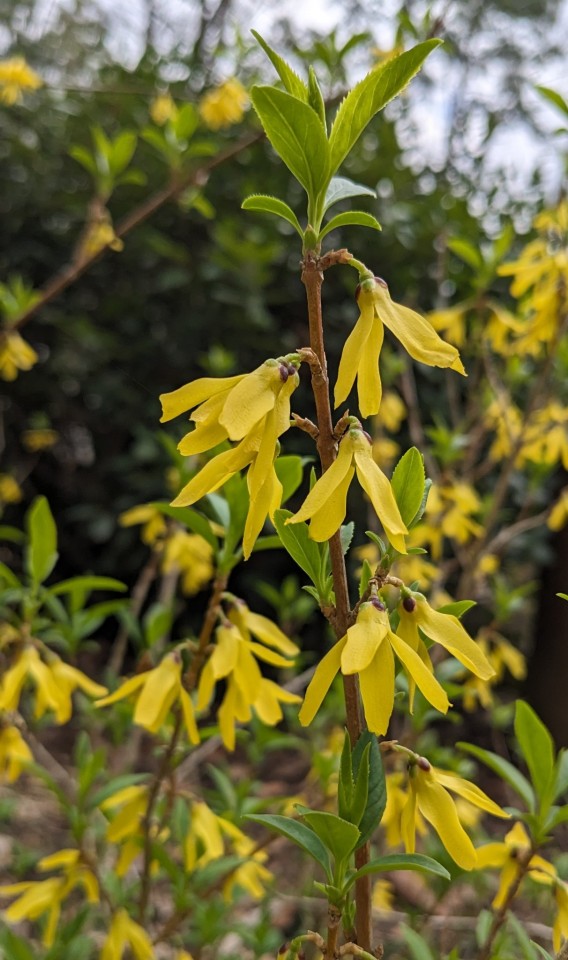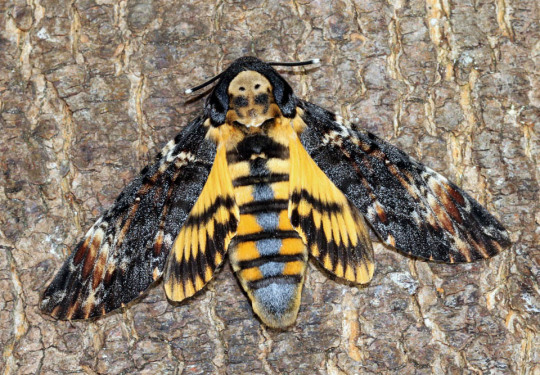#Oleaceae
Explore tagged Tumblr posts
Text
Heralds of Spring

Forsythia waiting eagerly in a lay-by to greet visitors on the Flower Field of the conservatory. Photo credit: Eleanor Chua.
This was taken against a maroon painted wall in a darker part of the conservatory. ISO had need to be set at 640 to get a 1/125-second shutter speed for the one-inch sensor camera.
#photographers on tumblr#flora fauna#flora photography#flower pics#forsythia photos#lumix photography#Oleaceae#panasonic fz1000#photography tips
30 notes
·
View notes
Text

Ligustro comune (Ligustrum vulgare L., Oleaceae) in fruttificazione
25 notes
·
View notes
Text


Syringa protolaciniata
Plants in the genus Syringa are known as lilacs, and they are native to Eurasia. Syringa vulgaris is the common lilac, widely grown in gardens in temperate regions of the world, and it is taller-growing than the plant pictured here. I have labeled my photo Syringa protolaciniata, but its name and origins are in dispute. Many people think this plant is a hybrid originating in southern Asia, perhaps in Iran or Afghanistan, but in any case it is much shorter than S. vulgaris, though it shares the delightful fragrance for which lilacs are famous. It belongs to the Oleaceae, or Olive Family.
-Brian
25 notes
·
View notes
Text

forsythia.
3 notes
·
View notes
Text

Forsythia suspensa / Weeping Forsythia at the North Carolina Botanical Gardens at the University of North Carolina at Chapel Hill in Chapel Hill, NC
#Forsythia suspensa#Forsythia#Weeping Forsythia#Oleaceae#Flowers#Nature photography#photographers on tumblr#UNC#UNC-Chapel Hill#Carolina#Chapel hill#Chapel hill NC#North Carolina#North Carolina Botanical Gardens#NCBG
2 notes
·
View notes
Text
#2274 - Ligustrum ovalifolium - Japanese Privet

AKA Korean privet, California privet, garden privet, and oval-leaved privet.
A flowering shrub or small tree from the olive family, native to Korea and Japan, naturalised in many other areas, and invasive in North America. Deciduous in colder areas. Fast-growing, and flowers and fruits abundantly, which many insects (such as bumblebee here) and birds appreciate, but all parts of the plant are poisonous to humans.
Tokaanu, Taupo Volcanic Zone, New Zealand
0 notes
Text
मोगरा IJasminum_sambac I Ulcer_Acid_reflux_अम्ल प्रतिवाह_Migraine_माइग्रेन_Pruritus_खुजली_सोरायसिस
Safer-Effective-Better-Remedy
sciatica #flowers #fitness #spas #seed #greentea #antidote #liver #infusion #spleen #मोगरा #Jasminum_sambac #Ulcer #Acid_reflux #अम्ल प्रतिवाह #Migraine #माइग्रेन #Pruritus #खुजली #सोरायसिस #psoriasis #inflammation #bronchodilator #oleaceae #hepatorprotective #diabetes #malaria #antifilarial #ulcer #immunitybooster #fever #vegan #stroke #illness #pathology #herbalmedicine #pandemic #healing…
youtube
View On WordPress
#acid_reflux#Ayurveda#Cultivation#Headache#Homoeopathy#Jasminum_sambac#Medicinal plants#Migraine#Mogra#Oleaceae#One health concept#psoriasis#Remedies#Veterinary#Youtube
0 notes
Text
people who dont like olives. why do u hate having little fruits in ur life
9 notes
·
View notes
Text


Ligustro lucido (Ligustrum lucidum W.T.Aiton, Oleaceae)
40 notes
·
View notes
Text

Abeliophyllum, the miseonnamu, Korean abeliophyllum, white forsythia, or Korean abelialeaf, is a monotypic genus of flowering plants in the olive family, Oleaceae. It consists of one species, Abeliophyllum distichum Nakai, endemic to Korea, where it is endangered in the wild, occurring at only seven sites.
6K notes
·
View notes
Photo
[ID 1: A flag with 9 horizontal stripes. The stripes from top to bottom are purple, lavender, orangish white, pastel yellowish green, green, pastel yellowish green, orangish white, lavender, purple. Overlaid on the flag is the Mozilla bouquet emoji.]
[ID 2: A flag with 9 horizontal stripes. The stripes from top to bottom are purplish pink, pastel purplish pink, orangish white, pastel yellowish green, green, pastel yellowish green, orangish white, pastel purplish pink, purplish pink. Overlaid on the flag is the Mozilla bouquet emoji.]
[ID 3: A flag with 9 horizontal stripes. The stripes from top to bottom are pastel purple, pale purple, orangish white, pastel yellowish green, green, pastel yellowish green, orangish white, pale purple, pastel purple. Overlaid on the flag is the Mozilla bouquet emoji.]
[ID 4: A flag with 9 horizontal stripes. The stripes from top to bottom are dark purplish grey, light yellowish grey, orangish white, pastel yellowish green, green, pastel yellowish green, orangish white, light yellowish grey, dark purplish grey. Overlaid on the flag is the Mozilla bouquet emoji.]






Row 1: Lavenderbouquetic and Orchidbouquetic Row 2: Lilacbouquetic and Hyacinthbouquetic ⛲⛲-🌼🌼-⛲⛲-🌼🌼-⛲⛲
1. Lavenderbouquetic - tldr; a gender that is connected to or influenced by bouquets of lavender. a gender that is connected to or influenced by bouquets of lavender. It may also be connected to lavender in general.
2. Orchidbouquetic - tldr; a gender that is connected to or influenced by bouquets of orchids. a gender that is connected to or influenced by bouquets of orchids. It may also be connected to orchids in general.
3. Lilacbouquetic - tldr; a gender that is connected to or influenced by bouquets of lilac. a gender that is connected to or influenced by bouquets of lilac. It may also be connected to lilac in general.
4. Hyacinthbouquetic - tldr; a gender that is connected to or influenced by bouquets of hyacinths. a gender that is connected to or influenced by bouquets of hyacinths. It may also be connected to hyacinths in general.
⛲⛲-🌼🌼-⛲⛲-🌼🌼-⛲⛲

#flowers#asterids#lamiales#lamiaceae#nepetoideae#lavenders#asparagales#orchids#oleaceae#lilacs#asparagaceae#hyacinths
33 notes
·
View notes
Text
Moth of the Week
African Death’s-Head Hawkmoth
Acherontia atropos

The African death's-head hawkmoth is part of the family Sphingidae and is the most widely recognized of the three species of Death’s-Head Hawkmoth. The species was described in 1758 by Carl Linnaeus. Its common name comes from the skull shape on the back of its thorax. It’s binomial name comes from the river Acheron in Greece, which was believed to lead to the Underworld, and the Greek goddess Atropos respectively.
Description The forewings are black/brown with mottled shades of brown while the hindwings are buff orange with two black/brown stripes that curve with the edge of the hindwing. The head and thorax are the same black/brown color as the forewings interrupted by the brown skull on the back of the thorax. The abdomen is the same buff color as the hindwings with similar stripes of the same color. There is also a single stripe down the center of the abdomen called the “dorsal stripe.”
Average Wingspan: 13 cm (5 in)
Females are large than males with a rounded abdomen tip and larger, thicker antennae
Males have a pointed abdomen tip
Diet and Habitat Larva of this species mainly eat the leaves of potato plants which have alkaloids. The larva accumulate these toxins to become unpalatable to predators. Adults eat the nectar of flowers and stolen honey from the beehives of the Western Honey Bee. They are able to mimic the scent of bees and steal the honey undetected. They use their proboscis, a tube used to drink nectar and honey, to break the honey comb.
Their ranges stretches from the Middle East, as far south as the southern tip of Africa, as far north as southern Great Britain, as far east as India and western Saudi Arabia, and as far west as the Canary Islands and Azores. It is known to move into western Eurasia, but a majority do not survive the winter.
Mating This moth has multiple generations per year. In Africa, the broods are continuous. In the northern range, the larva overwinter in the pupal stage. Eggs are laid singly on the underside of species in mainly Solanaceae but also Physalis, Verbenaceae, Cannabaceae, Oleaceae, Pedaliaceae and others.
Predators This moth can emit a special squeak noise by sucking in air to vibrate a flap in its mouth and throat. The purpose of this squeak is unclear, but the two hypotheses are it is to scare away predators or to mimic the sound of a queen bee makes for the workers to stop moving to easier raid beehives for honey. They are also immune to bee venom and can mimic the scent of bees.
Fun Fact This moth has appeared many times in pop culture as symbols of death and evil:
It appeared in The Hireling Shepherd, Bram Stoker's Dracula, Un Chien Andalou, the promotional marquee posters for The Silence of the Lambs, in the music video to Massive Attack's single, "Butterfly Caught,” and on the American edition's cover of José Saramago's novel Death with Interruptions.
It is mentioned in Susan Hill's Gothic horror novel I'm the King of the Castle and John Keats’s "Ode to Melancholy.”
It is referred to in The Mothman Prophecies.
Finally, the moth is used as a calling card by the serial killer Buffalo Bill. However, in the movie script they are referred to under a different species of death’s-head hawkmoths.
(Source: Wikipedia, Simple English Wikipedia)
#libraryofmoths#animals#bugs#facts#insects#moth#mothoftheweek#lepidoptera#Sphingidae#African death’s-head hawkmoth#Acherontia atropos
168 notes
·
View notes
Text
Flowers of Mythology - Lilac



Syringia, or lilacs, is a genus of 12 species of perennial woody plants that are part of the olive family, Oleaceae, native to southeastern Europe into eastern Asia and scrub and woodlands. They are trees that range from 2-10m tall with stems that can be up to 30cm in diameter. The flowers are quite small being 5-10mm in diameter, range from light purple to white, pale yellow, and pink, and come in densely packed forms known as panicles, which are complex spike-like formations. They bloom from mid spring through early summer and several of the species have a strong fragrance. While not used commercially, lilac wood is a hardwood that is good for wood turning with the outer wood being cream colored and the heartwood having streaks of purple and brown. They've been used for treating cough, diarrhea, and other abdominal complaints traditionally and modern research has shown that compounds extracted from lilac can be used to treat tumors, hypertension, inflammation, and certain fungal infections.

source: https://artoffairytale.com/dulac/pan_and_syrinx.html
In Greece, Pan, the god of the wild and nature, was wandering through a woodland and found Syrinx, a beautiful and chaste nymph who was minding her who business. He fell immediately in burning lust with her and began to pursue her. She fled from him and since, like most Greek gods of myth, he couldn't take a hint, he chased her. She approached a river and called out to the Potamides, river nymphs, to help her get away and they turned her into lilac. Pan, again like most Greek gods, didn't take rejection well at all. He continued to seek her, sensing her around the plant. He seized stems of the lilac and fashioned his eponymous flute of the stems. (Some versions claim she was turned into cattails.) Syringia is the Latinized version of her name.
7 notes
·
View notes
Text

My retexture for "wild olive" wood, a generic tree representing the family Oleaceae, for the Prehistoric Nature mod.
It's kinda funny how much of my art has just been wooden doors.
84 notes
·
View notes
Text





Syringa - sy·rin·ga (sə-ˈriŋ-gə)
noun
1. a plant of the genus Syringa (family Oleaceae ), especially (in gardening) the lilac.
#dnd#cosplay#larp#ren faire#renaissance festival#dnd oc#druid#werewolf#children of Gaia#werewolf the apocalypse#pathfinder#5e#dnd druid#dnd 5e
12 notes
·
View notes
